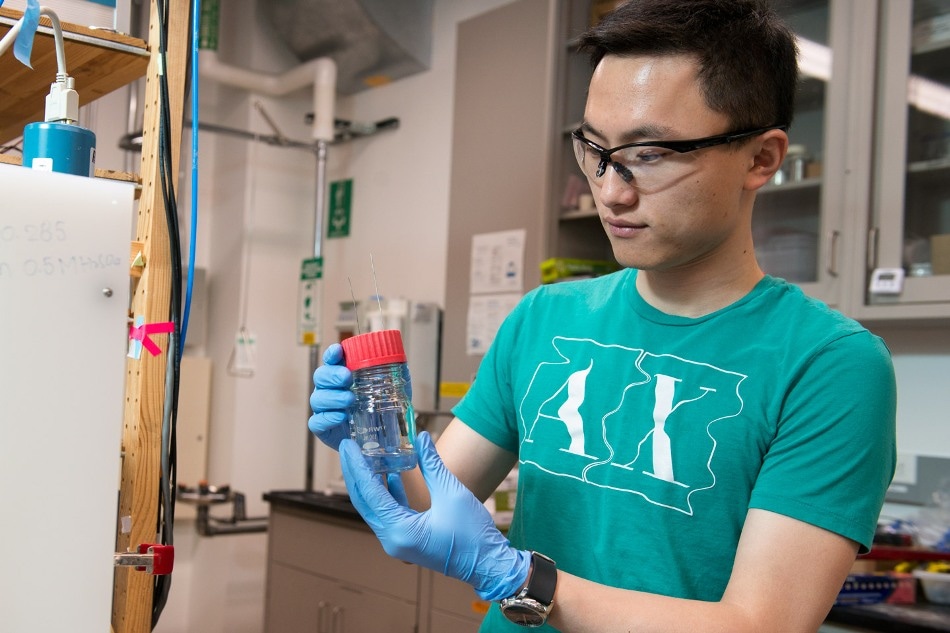Nov 25 2016
According to a new study conducted by a Stanford research team, a nanosize squeeze is sufficient to drastically boost the performance of platinum catalysts that help produce energy in fuel cells.
A platinum catalyst was bonded to a thin material that had the capacity to expand and contract as electrons moved in and out. The team discovered that squeezing the platinum just a fraction of a nanometer virtually doubled its catalytic activity. Their research findings are published in the November 25 issue of the Science journal.
 Former Stanford graduate student Haotian Wang is lead author of a new study that could lead to better fuel cells and other clean energy technologies. (Image credit: L.A. Cicero)
Former Stanford graduate student Haotian Wang is lead author of a new study that could lead to better fuel cells and other clean energy technologies. (Image credit: L.A. Cicero)
In this study, we present a new way to fine-tune metal catalysts at the atomic scale. We found that ordinary battery materials can be used to control the activity of platinum and possibly for many other metal catalysts.
lead author Haotian Wang, a former graduate student at Stanford now at Harvard University
The new method can be applied to a broad range of clean technologies, Wang said, as well as fuel cells that use platinum catalysts to produce energy, and platinum electrolyzers that split water into hydrogen and oxygen fuel.
Our tuning technique could make fuel cells more energy efficient and increase their power output. It could also improve the hydrogen-generation efficiency of water splitters and enhance the production of other fuels and chemicals.
Co-author Yi Cui, a professor of materials science and engineering at Stanford and of photon science at the SLAC National Accelerator Laboratory.
Electronic structure
Catalysts are used to make chemical reactions to go faster while using less energy. A metal catalyst’s performance depends on its electronic structure – that is, the way the electrons orbiting individual atoms are placed.
The electronic structure of a catalyst needs to match the molecule of interest in order to achieve the chemical reaction you want. You can adjust the electronic structure of a catalyst by compressing the atoms or pulling them apart.
Wang
The research team established a novel way to compress or divide the atoms by 5 %, a mere 0.01 nm.
“That might not seem like much, but it’s really a lot,” Cui said. “How did we achieve that? It’s really a marriage of battery research and catalysis.”
Experimental electrode
The research explored lithium cobalt oxide, a material extensively used in batteries for cellphones and other electronic gadgets. The Stanford team stacked many layers of lithium cobalt oxide together to develop a battery-like electrode.
Applying electricity removes lithium ions from the electrode, causing it to expand by 0.01 nanometer. When lithium is reinserted during the discharge phase, the electrode contracts to its original size.
Cui
For the experiment, the research team incorporated many layers of platinum to the lithium cobalt oxide electrode.
“Because platinum is bonded to the edge, it expands with the rest of the electrode when electricity is added and contracts during discharge,” Cui said.
Performance
Wang stated that by separating the platinum layers a distance of 0.01 nm, or 5 %, a major impact on performance was achieved.
“We found that compression makes platinum much more active,” he said. “We observed a 90 percent enhancement in the ability of platinum to reduce oxygen in water. This could improve the efficiency of hydrogen fuel cells.”
Extending the electrode by 5 % had the opposite effect, curbing oxygen production by 40 %, Wang said.
This is a dream experiment for a theorist. We predicted theoretically some years ago that straining a catalyst can be used to control its performance, and here is the experiment to show that our theory works well.
Research co-author Jens Nørskov, a professor of chemical engineering at Stanford’s SUNCAT Center for Interface Science and Catalysis.
“Our technology offers a very powerful way to controllably tune catalytic behavior,” Cui added. “Now, mediocre catalysts can become good, and good catalysts can become excellent.”
Additional Stanford co-authors on the paper are Fritz Prinz, a professor of mechanical engineering and of materials science and engineering, Shicheng Xu, Charlie Tsai, Chong Liu, Jie Zhao, Yayuan Liu and Hongyuan Yuan. Frank Abild-Pedersen, a SLAC staff scientist at the SUNCAT Center, was also a co-author.
The research received funding from the U.S. Department of Energy, the Stanford Global Climate and Energy Project, the Stanford Interdisciplinary Graduate Fellowship Program and the National Science Foundation Graduate Research Fellowship Program.